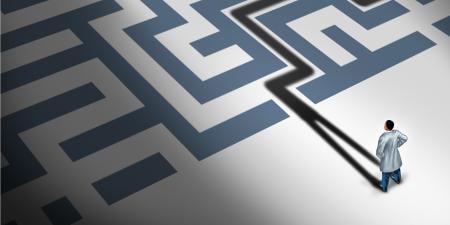I can recall writing a note in Walter’s chart like it was yesterday [1]. It began, “This is the 200th emergency department visit for Walter this year,” and it was only mid-summer. Less than 6 months later accounts of this infamous patient’s last days circulated though the hospital. In a strange way, I felt as though a family member had died.
Walter had been a fixture in our department for many years. Every physician in the emergency department knew him well, as did many of the internal medicine physicians. Nurses and technicians were on a first-name basis with Walter, who was renowned not only in our department but in most emergency departments in the city.
Encounters with Walter were always difficult at best. He would wander in at random times with vague or chronic complaints. With his head down, he would shuffle into the waiting room mumbling complaints in a monotone, high-pitched voice to the triage nurse. Refusal to cooperate with care was his custom. He would be found sitting in his assigned room, nearly every square inch of his body covered with ragged, unwashed clothing. A sweatshirt hood (or two) often covered his head. Taking of vital signs was usually refused, as was most diagnostic testing. House staff were often surprised to learn that Walter was neither uneducated nor homeless. In fact, he held an advanced engineering degree and, despite roaming the hospital campus at all hours of the day, owned his own home.
In spite of his usual vague and chronic complaints, Walter had advanced congestive heart failure. He was one of those patients always ill enough to be admitted to the hospital, even on his best days. He had chronic hypoxia, severe edema of his lower extremities, and chronic renal insufficiency. Discussions about administering furosemide were usually met with arguments by Walter about how it would affect his renal function coupled with refusal of a lab test for a serum creatinine. Walter firmly resisted any suggestion for hospital admission but was often so ill that he lacked the energy to refuse. These times offered a respite for the emergency department. It was easy to tell when Walter was in the hospital; those were the days when he wasn’t in our emergency department.
The crux of the matter was Walter’s underlying paranoid schizophrenia, which he refused to acknowledge. In fact, the one sure way to get him to leave the emergency department was to threaten to consult psychiatry. Mere mention of the service would result in cries of anguish, and his elopement from the department would soon follow. Surprisingly, this strategy was seldom used. Perhaps the staff realized that efforts to address his underlying psychiatric illness would be futile. Walter was never a threat to others or to himself, except for his medical noncompliance.
Descriptions circulating through the hospital surrounding the circumstances of Walter’s death were troubling. He had been admitted for worsening dyspnea and, as usual, had refused most interventions. His status declined, prompting his transfer to the intensive care unit where psychiatry was consulted. Numerous therapeutic modalities were then imposed, but Walter’s condition continued to worsen, and he eventually succumbed to his illness. One can only imagine the anguish resulting from his loss of autonomy during his final days.
Discussion
Patients who are regulars in emergency departments have been given many titles including “frequent flyers.” The “problem” is not unique to the United States. English-language literature describing the characteristics of these patients and the issues surrounding their emergency department care comes from many countries [2-9]. The implication is usually that patients are somehow using the emergency department in an inappropriate manner. Studies have clearly shown, however, that about half have chronic medical conditions, and for a variety of reasons most are not able to be seen in the offices of primary care physicians [2, 4-6, 8, 10-12]. Furthermore, these patients comprise a complex group that is in constant flux. The majority frequent the emergency department for a short period of time, usually less than 1 year, but there is a small minority that visits the emergency department over a long period of time, often many years [11]. This subgroup is studied little but is often the source of emergency department lore [13].
Walter is one of the few who maintained his familiarity with the emergency department staff over time. Like many patients in this subgroup, he was labeled “difficult,” a label that is fraught with problems. Descriptions and categorizations of so-called difficult patients have been in existence for many years, the modern classic being Groves’s article, “Taking Care of the Hateful Patient” [14]. The term is used to indicate that such patients are noncompliant, manipulative, and self-destructive. Differing expectations on the part of patient and physician can produce mutually negative outcomes in the medical encounter. Two traditional physician views present barriers to an ideal patient-physician relationship: the concept itself of the difficult patient and a biomedical view of medicine that tends to exclude social conditions. Patients like Walter are perceived by medical caregivers as “at fault” for poor medical outcomes. In many of these cases, unaddressed psychosocial issues are the root of the patients’ repeat visits, but attempts to manage those issues don’t necessarily reduce the number of emergency department encounters [15]. Phillips et al., for example, found that case-management strategies increase emergency department utilization, even while having a positive effect on some psychosocial factors for frequent users [3].
There are common factors among the frequent user group. Those with poor health, low income, psychiatric illness, substance misuse, and public insurance are more likely to be frequent users [8, 12, 16, 17]. Health insurance seems to otherwise not matter, nor does access to care [18].
Few studies have examined the underlying reasons that patients frequent the emergency department. Examining the issue from the patient’s perspective, Olsson and Hansagi found that frequent emergency department visitors perceive pain or other symptoms as a threat to their life or personal autonomy [9]. Overwhelming anxiety compels them to seek urgent help. Satisfaction with care becomes adversely affected when the patients sense that the emergency department staff classifies their frequent visits as inappropriate or when their symptoms are belittled.
In our case, Walter developed long-term relationships with various members of our emergency department staff. Many suspected that, like the ultimate frequent flyer, Walter had a social, albeit dysfunctional, relationship with them [13]. It is interesting that resources tend to be used in a more efficient manner on the long-term subgroup of frequent users than on the short-term group. Perhaps emergency department providers streamline the evaluation process due to familiarity with the patient, or they come to terms with the conflicting goals of therapy that are so troubling in encounters with difficult patients. My last few encounters with Walter were cordial and, in fact, quite rewarding. Accepting the limitations on care imposed by the patient, being willing to deviate from what most physicians would label “standard of care,” and patience were universally rewarded. Here, respect for patient autonomy was all that was demanded and took priority over other values. Not all of our colleagues agreed with this approach, but expanding care to include psychosocial as well as medical needs led to a rewarding patient-physician relationship.
Many do not consider the emergency department to be a place where long-term relationships are typically built. Cases like Walter’s, however, illustrate that the potential for them exists here. Emergency department physicians do, on occasion, form deep, meaningful relationships with their patients. Today, other patients have taken Walter’s place in our department. Some of them are quite objectionable, but all seem to have unique psychosocial needs that present an almost daily challenge. Meeting these needs and improving their lives continues to be a rewarding experience.
References
-
Pseudonym used.
-
Kennedy D, Ardagh M. Frequent attenders at Christchurch Hospital’s Emergency Department: a 4-year study of attendance patterns. N Z Med J. 2004;117(1193):U871.
- Phillips GA, Brophy DS, Weiland TJ, Chenhall AJ, Dent AW. The effect of multidisciplinary case management on selected outcomes for frequent attenders at an emergency department. Med J Aust. 2006;184(12):602-606.
- Byrne M, Murphy AW, Plunkett PK, McGee HM, Murray A, Bury G. Frequent attenders to an emergency department: a study of primary health care use, medical profile, and psychosocial characteristics. Ann Emerg Med. 2003;41(3):309-318.
- Salazar A, Bardes I, Juan A, Olona N, Sabido M, Corbella X. High mortality rates from medical problems of frequent emergency department users at a university hospital tertiary care centre. Eur J Emerg Med. 2005;12(1):2-5.
- Dent AW, Phillips GA, Chenhall AJ, McGregor LR. The heaviest repeat users of an inner city emergency department are not general practice patients. Emerg Med (Fremantle). 2003;15(4):322-329.
-
Fulde GW, Duffy M. Emergency department frequent flyers: unnecessary load or a lifeline? Med J Aust. 2006;184(12):595.
- Williams ER, Guthrie E, Mackway-Jones K, et al. Psychiatric status, somatisation, and health care utilization of frequent attenders at the emergency department: a comparison with routine attenders. J Psychosom Res. 2001;50(3):161-167.
- Olsson M, Hansagi H. Repeated use of the emergency department: qualitative study of the patient’s perspective. Emerg Med J. 2001;18(6):430-434.
- Kne T, Young R, Spillane L. Frequent ED users: patterns of use over time. Am J Emerg Med. 1998;16(7):648-652.
- Ruger JP, Richter CJ, Spitznagel EL, Lewis LM. Analysis of costs, length of stay, and utilization of emergency department services by frequent users: implications for health policy. Acad Emerg Med. 2004;11(12):1311-1317.
-
Zuckerman S, Shen YC. Characteristics of occasional and frequent emergency department users: do insurance coverage and access to care matter? Med Care. 2004;42(2):176-182.
- Schaulis MD, Snoey ER. Three years, a thousand visits: a case study of the ultimate frequent flyer. Ann Emerg Med. 2001;38(1):87-89.
- Groves JE. Taking care of the hateful patient. N Engl J Med. 1978;298(16):883-887.
- Malone RE. Whither the almshouse? Overutilization and the role of the emergency department. J Health Polit Policy Law. 1998;23(5):795-832.
- Hunt KA, Weber EJ, Showstack JA, Colby DC, Callaham ML. Characteristics of frequent users of emergency departments. Ann Emerg Med. 2006;48(1):1-8.
- Mandelberg JH, Kuhn RE, Kohn MA. Epidemiologic analysis of an urban, public emergency department’s frequent users. Acad Emerg Med. 2000;7(6):637-646.
- Blank FS, Li H, Henneman PL, et al. A descriptive study of heavy emergency department users at an academic emergency department reveals heavy ED users have better access to care than average users. J Emerg Nurs. 2005;31(2):139-144.



